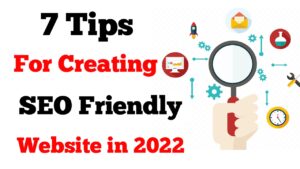Table of Contents
Create An SEO Friendly Website

How to Create An SEO Friendly Websitee in HTML.
SEO stands for Search Engine Optimization, and your website’s success depends on it.
Creating an attractive design and making sure all of your site’s information is easy to find and easy to understand will help you to increase traffic from search engines like Google, Bing, Yahoo, etc.
which will in turn increase the number of visitors to your site.
It sounds like a lot, but once you know the basics and focus on high-quality content at all times, you’ll create a website that increases traffic and draws in new readers who love your website as much as you do!
Use Keywords To Create An SEO Friendly Website
There are a lot of different things that go into making a website SEO friendly.
And while there is no surefire way to guarantee your site will rank well in search engines, following these guidelines will help you get on the right track.
- Keep it simple and clean A website with lots of distracting elements can be confusing for visitors and may not rank as well in search engines.
- Use keywords – Keywords play an important role when ranking in search engine results pages (SERPs).
Choose keywords that are relevant to your industry and make sure they are sprinkled throughout the site’s content.
- Optimize images – Images can slow down load times for your site, so make sure to optimize any photos you upload to keep loading time as short as possible.
Optimize Your Title Tags
When it comes to optimizing your site, you’ll want to make sure that you are focused on two primary things: your title tags and your content.
While there are a number of different ways in which you can go about optimizing both of these aspects, below are seven tips for creating an SEO-friendly website in HTML.
- Include keywords in the title tag. The first thing that you should focus on is making sure that the title tag has keywords included. This is not only important for human readers but also for search engine crawlers like Google, Bing, and Yahoo!
Optimize Your Meta Descriptions
Meta descriptions are the snippets of text that show up in Google search results, and they can be a powerful tool for persuading searchers to click on your page.
Here are some ideas for optimizing your meta descriptions
- Start with a sentence that summarizes your page’s content.
- Include keywords from your web page’s copy.
- Write for humans, not search engines.
- Be concise (don’t try to cram everything into one sentence).
- Stay on topic and don’t be overly promotional.
- Use active verbs to make it easier for people to understand what you offer without having to read further.
Optimize Your Header Tags
- Use the title tag to tell search engine crawlers what your site is about.
- Keep your meta description short and descriptive of your site’s content so that Google displays it when someone searches for keywords that are relevant to your site.
- Include links to other pages on your website in the header of each page, including a link back to the homepage from every page on the website.
- Set up your robots.txt file so that it tells search engine crawlers which files and directories should be crawled or not crawled.
Optimize Your Images
You want to make sure that your images are optimized for search engine visibility.
That means not just making them look great, but also making sure they are crawlable and readable by search engines.
You can do this by taking the following steps:
- Create a descriptive file name.
- Include keywords in the file name.
- Optimize the image size.
- Add ALT text for screen readers.
- Use good-quality images.
- Use captions.
- Fill in missing thumbnail metadata.
Optimize Your Anchor Text
The most important thing you can do is to make sure the text on your website is readable.
Search engines like Google and Bing use anchor text to determine how relevant a link is to a particular topic.
So when someone clicks on a link, they are taken to the destination site. If the anchor text of that link matches the topic of your website, then that’s great! You just increased your chances of appearing higher in search engine results pages (SERPs).
However, if you click on an unrelated link, it doesn’t bode well for you and your site will not rank as highly as it could have.
Optimize Your Webpages
Every page on your website should have a purpose.
If you don’t know what that purpose is, it’s time to revisit your website goals and start mapping out content.
Once you know the goal of each page, you’ll need to make sure that it’s optimized for search engines and has a high-quality title tag, meta description, header tags, and image alt text.
Be sure to include your targeted keywords in these places so that the search engine crawlers can find the content on your site.
